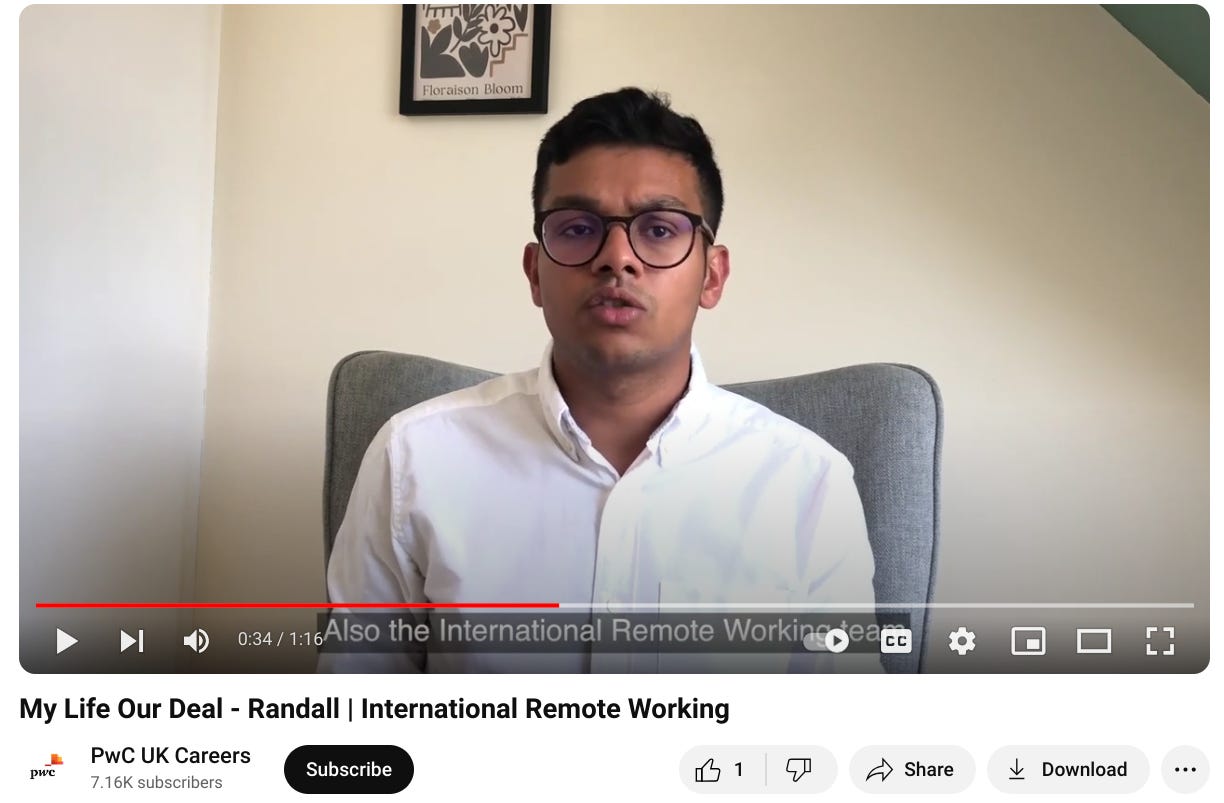Hello!
Thank you for joining me, I’m so glad you’re here.
April is shaping up to be fairly busy, and I’m excited to be doing a couple of speaking gigs during my month of Funemployment before I start my next role in May.
On the 25th, I’ll be speaking at a breakfast event in London about employer brand, along the theme of “are we allowed to do this?” Joined by my friends at Seenit, and Phil Smith, Employer Brand Manager at Santander, we’ll be talking about how to encourage employee advocacy, as well as how to build an engaging employer brand within “old school” organisations. The theme is very much linked to my upcoming role as well…!
The event is invite-only, so send me a message if you’re in employer branding and would like to come along.
I wanted to continue in the world of employer branding today, focusing on employee advocacy…or lack thereof, which has become massive with gen z.
Employee advocacy is when employees promote working somewhere, and can be through getting involved in careers fairs or being in promotional videos, it could also be them talking about the company on social media, either with their own words or within an advocacy programme.
Let’s look at PwC for examples of employee advocacy.
The video below is from their UK careers YouTube account is a brilliant example of great employee advocacy - the employee is comfortable sharing their story in a confident way, in front of the camera. The setup isn’t over-produced, so it feels authentic, while delivering a solid message about culture at PwC.
(Click to play; they disabled playback on other sites)
Another way PwC encourages people to be advocates is through a university ambassador programme, which can be really handy for things like careers fairs, but can be used as buddies throughout the year as well. It’s a cost-effective way to have living-breathing adverts for your organisation on campus.
On TikTok, they don’t have a UK specific channel, but on their US account they have quite a lot of “trend” content (such as the “we’re _____, of course we _____” which I admit is getting super boring now). They do, however have lovely clips like this one for Women’s History Month, using someone from their women’s network to give advice.
Using employee networks as sources for advocates is always a great route to already-engaged people. There’s a lovely TikTok video with employees talking about Black History Month.
It seems all well and good, but there are challenges to these kinds of activities. I got into a really interesting conversation in one of my later interviews, where the company was explaining that it’s hard to get a range of employees wanting to join in with social or video content; under-represented employees feel like they’re tokens in these situations.
It’s certainly a hard challenge to work with, though not one I’ve had too much trouble with personally so I can’t speak from experience about solutions, but I think that’s why working with employee networks is key. They are already engaged and hopefully committed to inspiring more people like them to join.
What can also help is explaining that you’re not asking them to lie and describe a place that it clearly isn’t - with any kind of employer branding, you want to attract a certain kind of people, but also be unattractive to certain kinds of people too. Communicating this to under-represented employees can help get them on board with things.
When employees use their own channels
This is where things get spicy. Because the stuff said on the official channels are only half the story - and more students than ever are using social media when researching employers.
At the end of the day, it’s a great position to be in when your employee feels proud about their work and wants to share their experiences. More and more gen z employees feel comfortable sharing snippets of their day, like this snapshot [TikTok] of an intern’s onboarding.
While there isn’t as much “meat” to it as a professionally created video, and doesn’t give that many insightful details, the fact that people can see behind the scenes, and access someone who is willing to answer questions will create positivity towards PwC as an employer. Currently 33k people have watched this video.
When I searched “My experience at PwC” in YouTube the first video that came up is this, which currently has 387k views:
This is where we get into the territory of employees (or in this case, a former employee) being a little bit more honest about the bad stuff as well as the good.
I really like how he explains his PwC experience through a happiness graph. He explains how he had to shadow people a lot at the beginning, and had to be proactive - which you may think would be negative, but again this adds to the right people applying and the wrong people turning away. This video might put off people who aren’t proactive.
There have been a few instances recently where gen z employees have recorded and published HR and layoff calls. In fairness, I couldn’t find any in the UK, so it seems to be a fairly US “trend” at the moment, but that’s not to say that British employees may not feel empowered to record things.
Here’s an example of a recorded layoff video, overlaid with someone giving critique on the people delivering the call [TikTok].
I think it puts a lot more pressure on leaders and HR to get these calls right; to really plan what they’re going to say and execute it in an empathetic way. Personally, I think that even in the most famous instances of these kinds of videos - the Brittany Peach recording of her layoff from Cloudflare [TikTok] - the HR rep and the manager did answer her questions pretty well. These people are the messengers, not the people who made the decision, so it’s hard for them to go into too many details.
At the end of the day, just like with Glassdoor, it’s an impossible task to try to try to control what people choose to say online. Employers may try their best to create a wonderful working environment for people, but you’re never going to please everyone. Being explicit about the behaviours and values in a company can help shape a culture, and deter people who won’t fit in with the desired state.
So let’s bring it back - some companies may want to encourage employees to use their own social channels to share their experiences, but not to the extent that they’re sharing overly negative things…and certainly not sharing confidential information. How do we go about this?
One easy way is through using employee advocacy tools, where employees can lift pre-written content and have it posted on their accounts, primarily LinkedIn. These are great in theory but can end up with overly marketed content going out, looking totally inauthentic and cold. Two of my former employers use tools like this and the content stands out like a sore thumb as I know that person would never write like that.
Having a community where people are encouraged to create their own content on certain topics can be a way to do this better. I previously had a group of recruitment leaders in India who kept posting out low-quality content about open vacancies, so I brought them together, gave them training on what makes great content, then had a group where I gave them prompts about things they could talk about. It both helped them shape the content when they wanted to talk about open roles, but also fed in other wider topics that would help flesh out our employer brand.
I think the biggest thing you can do, though, is talk about the fact employees may want to use their own social media to talk about work. If you’re the type of place where you want none of that (like Apple [PM Magazine]) then being upfront about that is crucial from onboarding, if not earlier. Setting expectations about what isn’t permitted - but what is encouraged - will help employees understand where the line is.
It depends on the employer and the industry I guess, but my view is that this is the future, and employees sharing experiences will only grow from here as the digital native generation age. If we don’t shape it now, it will get out of hand, but with some structure, it’s a brilliant tool to promote an organisation.
Let’s finish this section with a poll!
Links
Chris wrote another banging The Week in Careers newsletter [LinkedIn] (thanks for the shout out!) which included two very interesting sections: one about the rise in online careers coaching, often by people who don’t have such skills (a massive bugbear of mine), and another about how higher education careers services apparently don’t meet the needs of some students. I felt quite strongly about this, as I think if there are gaps, it should be met with better collaboration between employers and universities, rather than students feeling they need to pay to get ahead.
I’ve linked before about a young woman named Kelsey who makes TikTok content about newspapers, encouraging more gen z to read them. I love this new video [TikTok] from her about trust in news sources and how gen z not being able to think critically about what they read being a big issue.
I’ve been really enjoying Morning Brew’s content recently. They post about news and business in an engaging and accessible way. Here’s a great video about redundancies [TikTok].
Speed dating is popular [USA Today] amongst gen z, apparently. I think this speaks to the growing loneliness in young people, which is something employers and industry orgs could really do to support more with. Building belonging at work, and giving opportunities for young people to network is key to their wellbeing.
I was reading this very surprising article this morning about how gen z type in lower case, and need to learn to write properly when entering the workplace [Wall Street Journal - one free article]
Finally, a bit of a humorous take on today’s theme, with a comparison between tech influencers in 2020 and 2024 [TikTok].
I’ve not been scrolling as much this week apparently as I’m low on links! If you spot something that would be interesting to the Hiring Gen Z community, please do send it over!
Have a great week everyone!
Until next time,
Charlotte






